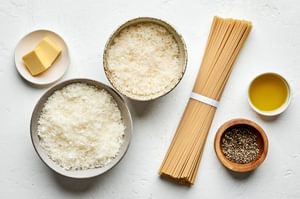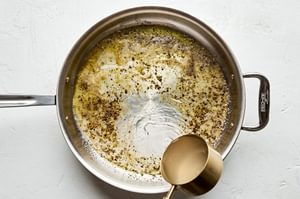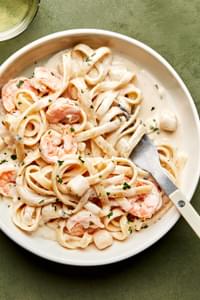We adore cacio e pepe! This creamy Roman pasta dish is an iconic celebration of pecorino romano (the “cacio”) and fruity, spicy, freshly ground black pepper (the “pepe”). You may be intimidated by it, or maybe you’ve even had a cacio e pepe disaster. But take a deep breath and channel some self-confidence — you can make creamy cacio e pepe! We’ll walk you through our authentic recipe, and share plenty of tips and tricks — like adding a little butter to the mix — to help you succeed! There’s really no faster, simpler, or more comforting dish than cacio e pepe (only Pasta Carbonara gives it a run for its money). It may feel a little tricky the first time you make it, but once you’ve mastered it, you’ll be so glad you did. For more delicious pasta ideas, get inspired by our Pasta Round Up.

Cacio E Pepe Ingredients List
Cacio: You may know that ‘formaggio’ is the Italian word for cheese, but cacio also refers to some cheeses, most typically (as in cacio e pepe) to Pecorino Romano, an aged Roman sheep’s milk cheese. For our cacio e pepe recipe, we also add Parmigiano Reggiano because we love it so much we simply can’t resist. If you want to be an absolute stickler for authenticity, you could use 100% Pecorino Romano, though.
Pepe: Fresh AND freshly cracked black pepper is key here, and plenty of it! Use the best quality black peppercorns you can get your hands on, and don’t use pre-ground. Done right, cacio e pepe is a dish that makes you stop and really notice how delicious — fruity, spicy, complex — black pepper is.
Pasta: You want a long pasta shape — spaghetti or bucatini are both pretty classic choices.
Butter: Look away, Romans! Including butter in our cacio e pepe is one of our favorite little tricks, even though it’s not considered strictly “authentic.” Adding a little butter helps the starchy pasta cooking water and cheese to emulsify into a creamy sauce (which is the trickiest dance of this entire recipe!) and it also tastes good because it’s BUTTER.




How To Make Cacio E Pepe, Step-By-Step
Begin with generously salted pasta cooking water. You’re going to use this water as the base of your cacio e pepe sauce, so treat it with respect and salt it well! If you’re not sure how to salt your pasta water, we’ve got a guide for you here.
Cook the pasta until it’s about a minute shy of al dente. It will finish cooking in the sauce, so you want to buy yourself a little time by undercooking it slightly here.
Start the sauce. You’ll melt the butter and olive oil together in a big skillet, and bloom the pepper in the fat to really draw out the peppery goodness.
Take a deep breath and get ready to work quickly, while everything is warm. Add the half of the pasta water you saved, and simmer it for a minute.
Now, add the warm, drained pasta and cheese. Vigorously, carefully and quickly, use tongs to toss pasta with the sauce. Move the pasta constantly. Consider the scientific magic that you are seeking: Emulsion! You’re asking the starchy water and the cheese and the water to emulsify into a creamy sauce, and the way you’re asking them to do that is by moving them around together quickly and constantly, and by having the heat just-so (low, but steady).
IF it starts to look like the cheeses are trying to clump up, add a little more pasta water. About a tablespoon at a time, as you move the pasta constantly. We swear that just believing it will work is part of the magic of cacio e pepe. Don’t stop believing, and keep your pasta water nearby.
Eat your cacio e pepe immediately! We’ve been known to grab our forks and eat it right out of the pan.


Tips For Foolproof Cacio E Pepe
Tips for perfectly al dente pasta: Honestly, this is something you’ll just need to get the feel for. Cook times will vary a bit brand to brand, shape to shape, so the very best cooking advice (for this recipe, and all recipes really) is to trust yourself, trust your palate, taste as you go. Start testing the pasta for al dente-ness when it’s 3-4 minutes from the cooking time that is suggested on the packaging.
A trick for saving the pasta water: dunk a Pyrex liquid measuring cup in to the pasta cooking water right before draining the pasta. They’re designed to handle high heat, and that handle is, well, handy! Once you’ve snagged your starchy water, you can drain the pasta like normal.
Grate the cheese yourself! Never use pre-shredded Pecorino or Parmesan. Pre-shredded cheeses typically have anti-caking agents added and they will 100% clump up instead of melting into a creamy cacio e pepe sauce. Instead, use your microplane grater to turn a hunk of amazing Italian cheese into the finest, most delicious powder.

More Deliciously Creamy Pasta Recipes
On To The Next One
For more recipe inspiration, follow us on Facebook, Instagram, TikTok and Pinterest or order our cookbook. We love when you share your meals. Tag us on Instagram using #themodernproper, and we’d love to hear what you think of this recipe in the comments below. Happy cooking!













